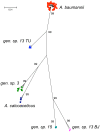The population structure of Acinetobacter baumannii: expanding multiresistant clones from an ancestral susceptible genetic pool
- PMID: 20383326
- PMCID: PMC2850921
- DOI: 10.1371/journal.pone.0010034
The population structure of Acinetobacter baumannii: expanding multiresistant clones from an ancestral susceptible genetic pool
Abstract
Outbreaks of hospital infections caused by multidrug resistant Acinetobacter baumannii strains are of increasing concern worldwide. Although it has been reported that particular outbreak strains are geographically widespread, little is known about the diversity and phylogenetic relatedness of A. baumannii clonal groups. Sequencing of internal portions of seven housekeeping genes (total 2,976 nt) was performed in 154 A. baumannii strains covering the breadth of known diversity and including representatives of previously recognized international clones, and in 19 representatives of other Acinetobacter species. Restricted amounts of diversity and a star-like phylogeny reveal that A. baumannii is a genetically compact species that suffered a severe bottleneck in the recent past, possibly linked to a restricted ecological niche. A. baumannii is neatly demarcated from its closest relative (genomic species 13TU) and other Acinetobacter species. Multilocus sequence typing analysis demonstrated that the previously recognized international clones I to III correspond to three clonal complexes, each made of a central, predominant genotype and few single locus variants, a hallmark of recent clonal expansion. Whereas antimicrobial resistance was almost universal among isolates of these and a novel international clone (ST15), isolates of the other genotypes were mostly susceptible. This dichotomy indicates that antimicrobial resistance is a major selective advantage that drives the ongoing rapid clonal expansion of these highly problematic agents of nosocomial infections.
Conflict of interest statement
Figures



References
-
- Dijkshoorn L, Nemec A, Seifert H. An increasing threat in hospitals: multidrug-resistant Acinetobacter baumannii. Nat Rev Microbiol. 2007;5:939–951. - PubMed
-
- Hoffmann MS, Eber MR, Laxminarayan R. Increasing resistance of Acinetobacter species to imipenem in United States hospitals, 1999-2006. Infect Control Hosp Epidemiol. 2010;31:196–197. - PubMed
Publication types
MeSH terms
LinkOut - more resources
Full Text Sources
Molecular Biology Databases
Research Materials
Miscellaneous

